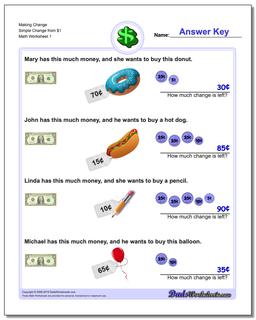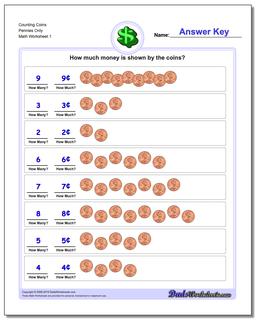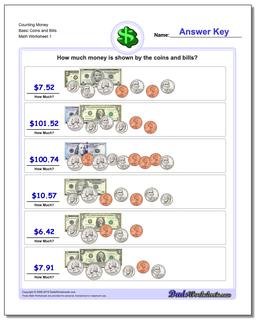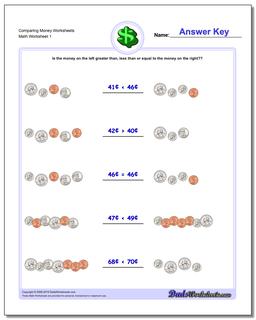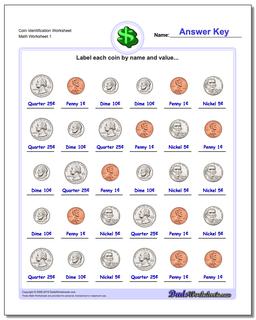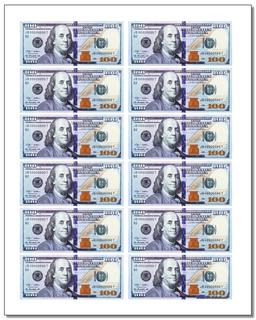Core Math Worksheets
Fraction Worksheets
Word Problems
Algebra and Trigonometry
Other Worksheets
Place Value
Percentages
Rounding Numbers
Ordering Numbers
Standard, Expanded, Word Form
Mean Median Mode Range
Ratio Worksheets
Probability Worksheets
Roman Numerals
Factorization, GCD, LCM
Prime and Composite Numbers
Pre-Algebra
Geometry Worksheets
Blank Clocks
Telling Analog Time
Analog Elapsed Time
Greater Than and Less Than
Money
Arithmetic Sequences
Geometric Sequences
Venn Diagram
Graph Worksheets
Measurement & Conversions
Patterns and Puzzles
Color by Number
Holiday & Seasonal
Early Learning
Printables
Calculators
Money
These printable money worksheets feature realistic coins and bills in problems for identifying coins, making change, counting coins, comparing amounts of money. They build foundational recognition and counting skills in Kindergarten and first grade to prepare for full money practice necessary to pass second grade.
Making Change
16 Money Worksheets
These worksheets allow kids to practice making change from a starting amount of money. There are worksheets that start with change from one dollar, progressing to change from whole dollars, and end with making change from dollars and cents.
Making ChangeCounting Coins
56 Money Worksheets
Counting coin worksheets, including PDF printables for counting and calculating sets of the same coin or of multiple types of coins. There are also worksheets with coins in order by denomination as well as in random order, just like they come out of your pocket...
Counting CoinsCounting Money
56 Money Worksheets
Counting coin worksheets, including PDF practice printables for counting and calculating sets of the same coin or of multiple types of coins. There are also worksheets with coins in order by denomination as well as in random order, just like they come out of your pocket...
Counting MoneyComparing Money
16 Money Worksheets
Comparing money worksheets present two different amounts of money as coins and bills, and grade school students determine if they are greater than, less than or equal to each other.
Comparing MoneyCoin Identification
4 Money Worksheets
These worksheets allow kids to practice coin identification using realistic images of the four most common US coins (quarters, dimes, nickels and pennies). Each printable PDF worksheet includes an answer key.
Coin IdentificationPrintable Play Money
11 Money Worksheets
These printable play money sheets can be cut up and used for classroom to teach money math, or as replacements for fake Monopoly money to make game play more realistic! PDF printables with coins and bill denominations from $1 to $100.
Printable Play MoneyGuide to the Money Worksheets
These free printable PDF money worksheets cover topics appropriate for early grade kids who are learning how to identify, count and compare physical money. As much as we think credit cards or digital transactions are becoming the new norm, the concept of money is best introduced to first and second grade students in a tangible form. These worksheets introduce several common money exercises, and they work well with the realistic printable money maniipulatives for hands-on exercises.
Learning Money Recognition Skills in Kindergarten
Kindergarten is a great time to introduce physical money and begin working on identification of coins and bills. The printable play money on this page also makes for a great scissor exercise, and the resulting paper currency can be used in games or imaginary play activities. Looking to replace that Monopoly money with something more educational? Try it out!
Counting Coins and Bills in First Grade
Starting in first grade, students should be able to not only identify denominations of coins, but also perform simple addition of coins and bills. First grade students may struggle still with combining whole dollars and cents (decimal arithmetic), but there are variations of the worksheets with counting coins only and counting money (bills) only that can ease this transition. From there, worksheets with coins and bills, including comparing money, are great practice for more advanced students
Making Change in Second Grade and Third Grade
Students in second and third grades should be very comfortable recognizing specific coins and bills, and they should know exactly what monetary value they correspond to.
These students should also be able to calculate the decimal value of combinations of coins and bills readily, and even start to make their own combinations of money from a decimal representation. The making change worksheets combine these concepts with simple decimal subtraction of monetary values.
Once students have reached this level of proficiency, they should feel comfortable tackling larger problems including exercises with $20, $50 and $100 bills.


